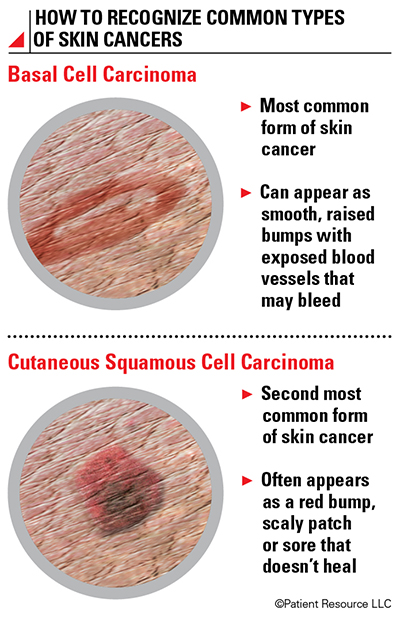Skin Cancers
Overview
Skin cancer often begins as precancerous lesions on your skin. Cancerous tumors, lesions and growths frequently appear on sun-exposed areas of the face, neck, chest, shoulders, back and arms, but can appear anywhere.
Your skin is your immune system’s first line of defense against infection and injury. Its thin, outer layer is called the epidermis, with the dermis underneath it and the hypodermis (subcutaneous tissue) farther below.
Skin cancers are named for the cells in which they develop: basal cell carcinoma (BCC) and cutaneous squamous (pronounced SKWAY-mus) cell carcinoma (CSCC). These two types of carcinomas are often grouped together and referred to as non-melanoma skin cancers (NMSCs). Merkel cell carcinoma (MCC) is among the many rare types, subtypes and variants of cancer that also affect the skin.
The tumor, node and metastasis (TNM) system developed by the American Joint Committee on Cancer (AJCC) is used to classify and stage skin cancer. Doctors categorize the tumor (T) according to its size and location, whether cancer cells are found in nearby lymph nodes (N) and whether the cancer has metastasized (M), or spread, to other parts of the body (see Staging). CSCC is also classified by tumor grades, which are different from the stages used to classify most other cancers.
Tumor grades are based on how closely the cells resemble normal, healthy cells when viewed under a microscope. The pathologist will examine cells through a microscope and then assign a number to the grade according to how different these cells are from normal.

Basal Cell Carcinoma (BCC)
The most common form of skin cancer in the United States develops in basal cells, which are round cells in the lower part of the epidermis. BCC has more than 20 subtypes and variants, and it tends to grow slowly and rarely spreads beyond surrounding tissues. It usually develops on the head, neck or shoulders and can appear as smooth, raised bumps with exposed blood vessels that sometimes bleed.
Cutaneous Squamous Cell Carcinoma (CSCC)
Less common than BCC, cutaneous squamous cell carcinoma (CSCC) is sometimes called squamous cell carcinoma of the skin or squamous cell skin cancer to differentiate it from squamous cell carcinoma that develops in other parts of the body.
CSCC develops in squamous cells, which form the surface of the skin. CSCC usually remains local, meaning it is confined to tissues surrounding the original site. Regional CSCC has spread to nearby lymph nodes, and metastatic CSCC has spread to distant parts of the body.
Actinic Keratosis
Commonly referred to as sun spots or age spots, actinic keratosis (pronounced ak-TIH-nik KAYR-uh-TOH-sis) is a common skin condition that usually forms on areas exposed to the sun, such as the face, scalp, back of the hands or chest, that have had long-term exposure to ultraviolet light. It is most common in people with fair skin and is also called senile keratosis and solar keratosis.
It may appear as a thick, scaly patch of skin that may become cancer. It is a subtype of cutaneous squamous cell carcinoma (CSCC). Actinic keratosis is considered a precancer because it rarely progresses to become CSCC, and, if detected early, can be treated before it develops into skin cancer.
Merkel Cell Carcinoma (MCC)
Typically appearing on sun-exposed skin as a single lump, this rare cancer forms in oval-shaped cells located in the lower part of the epidermis. These neuroendocrine cells are thought to be receptors that help produce the sensation of light touch. MCC begins when these cells become abnormal and grow out of control, most often in the head and neck area as well as on the trunk, arms and legs.
MCC grows rapidly and is likely to spread, first to nearby lymph nodes and then to distant areas. These may include skin and lymph nodes elsewhere in the body, the brain, lungs, bones and other organs.


